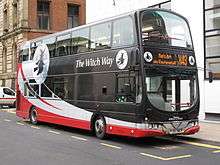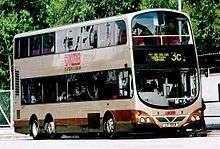Wright Eclipse Gemini
| Wright Eclipse Gemini | |
|---|---|
%2C_1_July_2015_(2).jpg) | |
| Overview | |
| Manufacturer | Wrightbus |
| Body and chassis | |
| Doors | Single or dual door |
| Floor type | Low floor |
| Chassis |
Volvo B7TL Volvo B9TL Volvo B5LH Volvo B5TL Volvo Super Olympian (Explorer) |
| Powertrain | |
| Engine |
Volvo D7C (Volvo B7TL) Volvo D10A (Volvo Super Olympian) Volvo D9B (Volvo B9TL) Volvo D5E (Volvo B5LH) Volvo D5F (Volvo B5LH) Volvo D5K (Volvo B5LH/B5TL) |
| Transmission |
ZF Voith Volvo I-SAM |
| Dimensions | |
| Length |
10.4 m (34 ft 1 in) dual-axle or 12 m (39 ft 4 in) triple-axle |
| Width | 2.52 m (8 ft 3 in) |
| Height | 4.23 m (13 ft 11 in) or 4.4 m (14 ft 5 in) |
The Wright Eclipse Gemini is a low-floor double-decker bus body built by Wrightbus since 2001, based in the single-deck Wright Eclipse design. The second-generation Eclipse Gemini 2 was launched in 2009, followed by the third-generation Gemini 3 in 2013. Additionally, the body was available on Volvo Super Olympian chassis in Hong Kong between 2003 and 2005, marketed as the Wright Explorer.
The original Eclipse Gemini was launched in 2001 on Volvo B7TL chassis; from 2006, the body was also built on the replacement Volvo B9TL chassis and, from 2013, on the B9TL's replacement, the Volvo B5TL. Since 2008, the body has also been available on Volvo B5LH hybrid chassis, with the first examples being delivered to Arriva London.
Wright Eclipse Gemini-bodied buses have been mass-introduced into London since 2001, where they replaced types such as the AEC Routemaster and Leyland Titan. It is also popular with FirstGroup, with over 1,000 buses being put into service with the group. Dublin Bus and Bus Éireann have also acquired a large number of Volvo B9TLs with Wright Eclipse Gemini bodywork.
First generation (2001–2009)

The Eclipse Gemini was launched in 2001, initially on Volvo B7TL chassis, as a double decker version of the existing Wright Eclipse body. The original Eclipse Gemini, and all versions up until the facelifted Gemini 3, have both the upper and lower deck front windscreens forming part of a single oval shape, with the destination blind in between.
In London, as with most buses, Eclipse Geminis often have two doors for passenger loading, one at the front and one in the centre; elsewhere, a single door at the front is more common. Also on London examples, the staircase is situated across from the centre entrance, while on single door variants, the staircase is located at the front, directly behind the driver's cab. The staircase itself differs from other modern buses as rather than simply having a banister, the Eclipse Gemini features a glass panel underneath the handrail, giving a stylish appearance.
All Eclipse Geminis are fitted with LED rear lights. Although London and Lothian models retain "power blinds" (electrically operated traditional destination boards), most Eclipse Geminis are fitted with LED destination screens. As is common on most new buses, stop request buttons appear on both floors and should these be pressed, the word "Stopping" appears in green on a black glass effect panel, much more streamlined than the traditional box housing. The interior of the Eclipse Gemini features curves similar to its exterior, and continues the modern feel.
2006 facelift

In 2006, the Volvo B7TL chassis was replaced by the new Volvo B9TL; at the same time, Wrightbus launched the facelifted version of the Eclipse Gemini on the new chassis. The updated styling on the facelifted version of the Eclipse Gemini is largely confined to the rear of the body, where it has a more rounded appearance compared to the original and a central LED route number panel, housed within a smoked glass effect panel underneath the upper rear window. Other external modifications include the relocation of the rear number plate from its integrated position with the upper rear window to a more conventional siting at the bottom of the bus.
Internally, the facelift consists of an extension of the driver guard panel to include the on-bus vault (passengers now must put their hand through a gap in the panel to reach the vault) and a slightly modified staircase separation wall, which now features a glass panel, presumably to improve the view of passengers sitting in the seat directly in front of the wall.
The Eclipse Gemini was also made available on the hybrid Volvo B5LH chassis in 2008. The first six hybrid Eclipse Geminis were delivered to Arriva London in 2008.
Wright Explorer

Between 2003 and 2005, Wrightbus bodied 100 Volvo Super Olympian chassis for Kowloon Motor Bus in Hong Kong; these received a modified version of the Eclipse Gemini body, marketed as the Wright Explorer. The bodywork was modified to fit the Super Olympian chassis, with the most noticeable difference being the tri-axle layout. The last Volvo Super Olympian to roll off the production line received Wright Explorer bodywork.
Subsequently, the Super Olympian was replaced by a tri-axle variant of the Volvo B9TL. Wrightbus offered similar tri-axle bodywork, which was unnamed and had slightly different rear styling, to the chassis. After the introduction of Euro IV-engined Volvo B9TL, this bodywork became known as the Eclipse Gemini tri-axle, but no bodywork carrying this name were known to have been built.
Second generation (2008–2015)
The second generation Wright Eclipse Gemini, known as the Eclipse Gemini 2, was launched in 2008 on Volvo B9TL and B5LH chassis. The Eclipse Gemini 2 features front and rear ends facelifted to match the Eclipse 2 single-decker, as part of Wrightbus' new design philosophy.
A low-height version was introduced in 2012. Like the Explorer, the Eclipse Gemini 2 has been sold in Hong Kong, including a tri-axle variant that replaced the Explorer. Kowloon Motor Bus and Citybus of Hong Kong and SBS Transit of Singapore have taken delivery of a substantial number of Eclipse Gemini 2s, the Singapore examples are locally assembled.
In March 2015, Delaine Buses of Bourne took delivery of AD15DBL, both the last Eclipse Gemini 2 and the last Volvo B9TL to be built for the United Kingdom and Ireland.[1] Production of the tri-axle Eclipse Gemini 2 continued, as no replacement of Volvo B9TL for Asian market had been announced as yet.
Third generation (2013–present)
The third generation Wright Eclipse Gemini, now known simply as the Gemini 3, was launched in 2013 for the new Volvo B5TL chassis, the eventual replacement of the B9TL, the Gemini 3 also remained available on Volvo B5LH hybrid chassis.
Some design features were taken from the New Routemaster, another Wrightbus design. The two most noticeable aesthetic changes were a substantial redesign of the rear end and the introduction of smaller upper deck windows to save weight; the front light clusters were also slightly redesigned, in order to incorporate separate LED daytime running lights for the first time.
2014 facelift
In 2014, to coincide with the launch of the integral Wright StreetDeck, the Gemini 3 underwent a facelift. Both the front and rear ends were substantially redesigned to match the StreetDeck. However, both the pre- and post-facelift versions of the Gemini 3 remain on sale concurrently.
Gallery
- Eclipse Gemini


%2C_21_June_2011.jpg)
 First Greater Manchester Volvo B9TL with route 17 & 18 branding in Shudehill Interchange
First Greater Manchester Volvo B9TL with route 17 & 18 branding in Shudehill Interchange
- Eclipse Gemini 2

- Kowloon Motor Bus Volvo B9TL (AVBWU class) in Hong Kong

%2C_SBS_Transit_(2016-01-04).jpg) SBS Transit Volvo B9TL in Singapore
SBS Transit Volvo B9TL in Singapore First Somerset & Avon B9TL Eclipse Gemini 2 at Showbus
First Somerset & Avon B9TL Eclipse Gemini 2 at Showbus
- Gemini 3
- Volvo B5TL demonstrator with Go-Ahead London
%2C_1_July_2015_(2).jpg) Lothian Buses Volvo B5TL with post-facelift Gemini 3 bodywork
Lothian Buses Volvo B5TL with post-facelift Gemini 3 bodywork
See also
Competitors
References
External links
| Wikimedia Commons has media related to Wright Eclipse Gemini. |